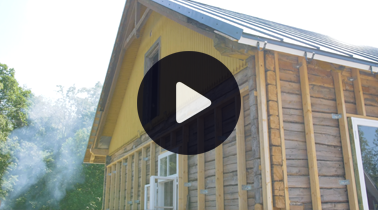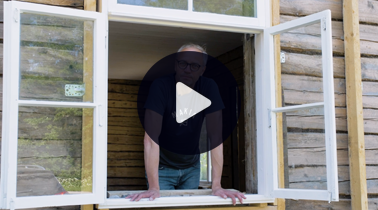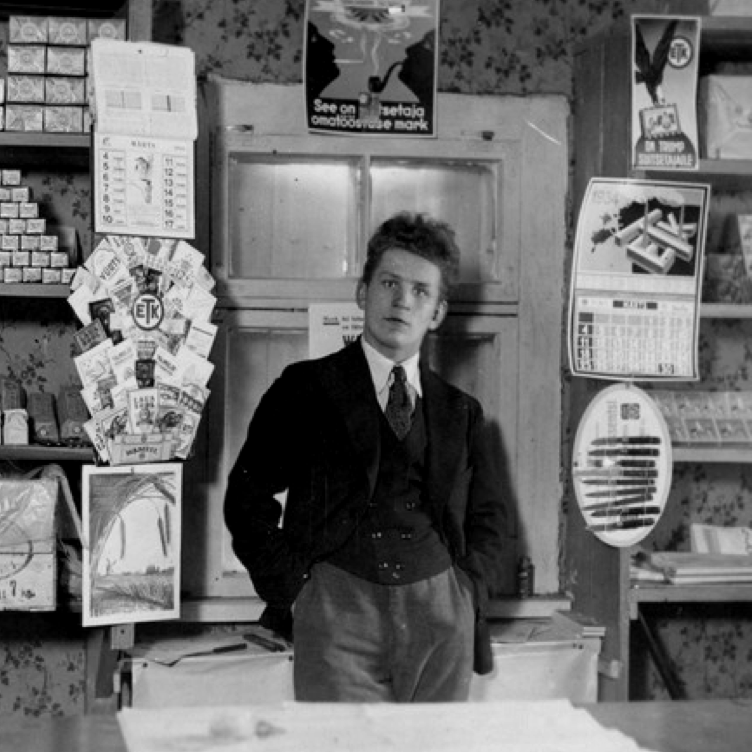
Background
The shop first opened its doors in Leesi in 1908. To manage the shop, local fishermen formed the Kolga-Leesi Kalameeste Kaubatarwitajate Ühisuse.
The cooperative did well and earned a profit from sales. Dividends were paid and opportunities were found to help local life. The Orthodox priest and the local mail carrier were supported. Musical instruments were purchased for the children of Leesi Primary School. Within a few years, the space rented to run the small shop became cramped, and in 1913 construction began on the shop’s own building.
The store operated successfully in this building until 2019, when the old dilapidated one was left empty. The last shopkeeper acted as a lessee and sold lemonade and ice cream from the shop during the summer. The depreciated building required a significant investment. It was only a matter of time before the ceiling would fall in. The old house was in poor condition, water had penetrated the structure of the wooden house through the ceiling, and it seemed to the locals that at least half of the building would need to be demolished. The shopkeeper did not have the resources to buy the building, so the shop was closed. The people of the peninsula had to get by without their shop, with the nearest shop being located a 30 minute drive from Loksa.
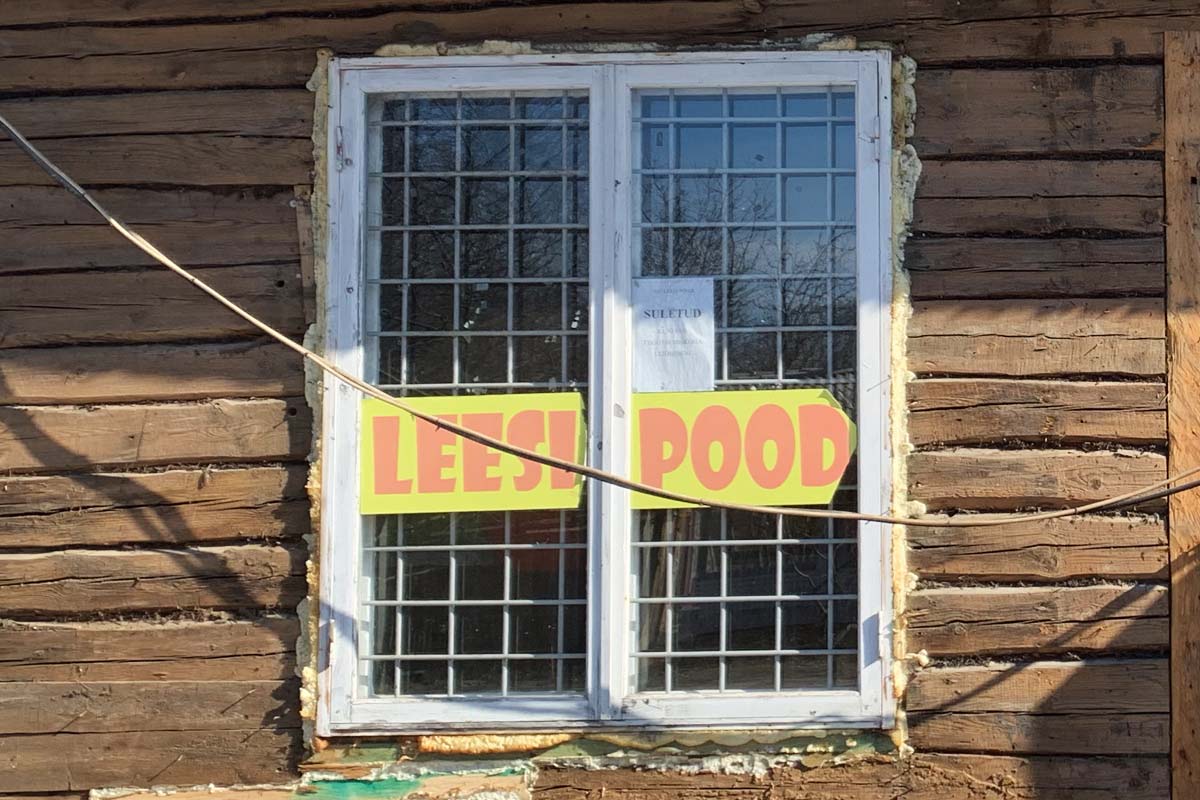
Idea
In the autumn of 2019, the former owner put the shop building up for sale. The chain stores were not interested in the building, and the locals – who had to take into account the possibility that the beloved shop in the middle of their village would become someone’s summer home – came up with the idea to buy and renovate the building.
The people of the peninsula were united by the practical need for a shop. The closest shops are located several kilometres away, in Loksa and Kuusalu. On the other hand, no one wanted to lose the community hub that had served as the centre of village life. From a business perspective the idea seemed to make sense. Each summer, more and more people are visiting the peninsula, and the number of permanent residents is also showing a growing trend in winter. They quickly took action.
In September-October 2019, negotiations were held with the owner regarding the price of the building. By the beginning of November, a reasonable agreement had been reached. At that point, it was not clear what the process for rescuing the shop should look like; however, there was a strong sense of the community putting its weight behind the effort.
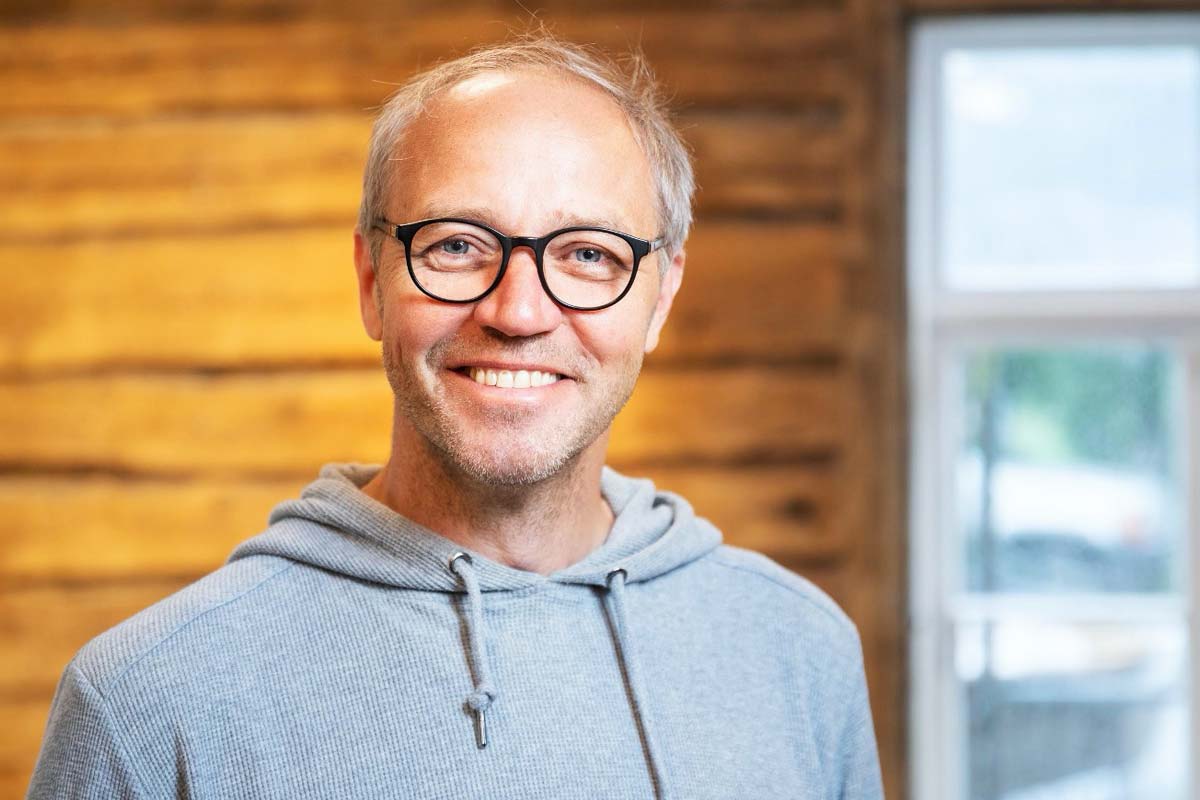
Planning
Ants Viirmaa, a local man, became the central force behind the project. The first thing that had to be done was to find out how many people would also be able to financially support the project. Ants spoke with the more active representatives of the community, who helped to spread the word – each to the residents of his or her village.
Team formation (November 2019)
Although the shop is located in Leesi, the restoration and reopening of the building is a joint venture between all ten villages on the peninsula. By the end of November, it was clear that at least twenty people were ready to contribute to the joint project with their wallets, acquaintances and their actions. The idea could move forward. When expanding the communication network, a core of community activists formed around Ants, who were ready to assume responsible roles for the success of the project.
Community agreement (November 2019)
At the end of November, a meeting was held where the Leesi Tarwitajate Ühisus was founded in the spirit of its predecessors. More than 70 local residents took part. The original plan was to hold a meeting to discuss whether the idea made sense. However, it turned out that the discussion was already focusing on how to reopen the shop. There was no doubt about whether or not this would be done. Membership in the association was made conditional on the contribution of EUR 1,000. The considerable contribution meant that the amount needed to buy the building was obtained in a few weeks.
Building purchase and planning (December 2019)
On 6 December, the partnership shook hands with the owner. The plan for the first season was to perform the renovation works themselves – something that could not be postponed under any circumstances – with the store set to open in the spring. The roof of the building, which was leaking, was in the worst condition – this was a critically important job. No major plans were made at that time.
January and February were set aside for planning. The first thing that was done was an expert from the Estonian Open Air Museum was invited to visit the site, to figure out what the renovation of the building actually required, in case there should be a desire to do more. He also determined which of the original details could still be restored and which of the added details had little value. By the end of February, it became clear what the prerequisites were for the complete renovation of the building in terms of both money and workload.

Initiation of repair works and the involvement of volunteers
The start of work in early spring coincided with the arrival of the global viral outbreak in Estonia. In retrospect, it can be stated that the special situation benefitted the restoration of Leesi’s shop.
Many people, who primarily reside in Tallinn and visit their peninsula cottages on weekends, came to stay around Juminda during the emergency situation. A significant number of these people agreed to help Ants, who was in charge of the renovation of the building, with his work. In this way, the work was undertaken and completed on a larger scale in the spring than had originally been planned.
Under conditions of isolation, the families worked in shifts lasting for a couple of hours at the shop. By doing so they avoided contact; even so, the work progressed quickly. Of benefit was the fact that we had a lot of people with essential skills – builders and construction supervisors to accountants – from which to choose.
Construction work was not planned in advance with great detail. In order to preserve as much of the old building as possible, it was necessary to work step by step, layer by layer. When each new roof, wall or ceiling layer was discovered, a decision had to be made on the spot: what to demolish, what to leave, and what to restore. As much as possible was performed by themselves. In the case of many of the more complex works, people to perform them were found from within the community introduction network, which Ants cites as an important resource. In this way a construction supervisor, an electrician and many other assistants were found. Many of them waived any sort of fee, because they were happy to contribute to the joint project.
Roof (March-April)
Replacing the old asbestos-cement roof was a top priority. It had to be replaced immediately and that’s where it started. When the old asbestos-cement was removed, it turned out that the roof structures were in surprisingly good condition for being 100 years old. The asbestos-cement roof was replaced with a tin roof. There was no need to change any of the rafters under the top layer.
Ceiling (March-April)
The ceiling was not visible anywhere until the top layers were removed. Therefore, it was not known how much water had flowed between the ceiling over time. Above the ceiling a layer of sawdust was removed, while a layer of Soviet-era plywood below it was removed, under which was boarding dating from the time of construction of the building. When the beams were reached, it turned out that the ceiling was the part of the building that had suffered the most damage. The last shoppers were unaware of the risk of collapse under which they made their purchases. In about a month, the necessary ceiling beams were replaced and a new ceiling was installed.
Removal of boarding (April)
The building’s lining was peeled layer by layer to assess, on an ongoing basis, how much water damage was hidden in the walls. Luckily, the majority of the walls had been well preserved. The lower row of logs was repaired. Many of the logs were replaced with new ones, while the renovation of others was sufficient.
Windows (April)
The decision was initially made to repair the windows from different periods of the building and to install new ones later. The windows, along with the frames, were taken down in one piece, and the organisers divided them between different farms. Each farm received a paint pot with the same colour code, so that the frames would all be painted the same colour, and it only took one week to tidy the frames.
Electricity and design work (April-June)
The initial plan was to complete the project first, and then the electrical works – as they really needed to be done. It soon became clear that when restoring an old house, things do not go as smoothly as when building a new building. The house often determines how the builder must act. An electrician must be available at all times to respond to new discoveries. You never know exactly where the refrigerator will come from, because you don't know where it will fit or where it can’t be placed, for example, due to a crooked wall. The project was carried out in parallel with the electrical works, because as soon as they were put down on paper they had to be redrawn.
Cleaning up of the calm traffic area (June)
The first phase of tidying up the surroundings of the shop building required two weeks of serious work. The area behind the building was cleared of stones and debris. A courtyard is planned, but more serious work involving the landscaping of the entire yard is planned for 2021.
Finishing (June)
The interior decoration of the shop was quite simple. The walls were cleaned, with the old logs creating a pleasant atmosphere in the shop. For the ceiling, we looked for boarding with an original profile, the colour of which was lightened. The old wooden floor was replaced with a modern alternative, because real wood is unable to withstand the heavy footfall found within a shop. The finishing of the shop took a little over two weeks.
Insulation and installation of new boarding (July)
As renovation began inside the building first, so that the store could start operating as soon as possible, the insulation took place after finishing. At the time of the opening, half of the store was insulated and windproof. Now the whole building is waiting for its exterior siding. As installing the siding requires greater precision, and the result remains visible to everyone, it was a time-consuming process that ended up taking four weeks.
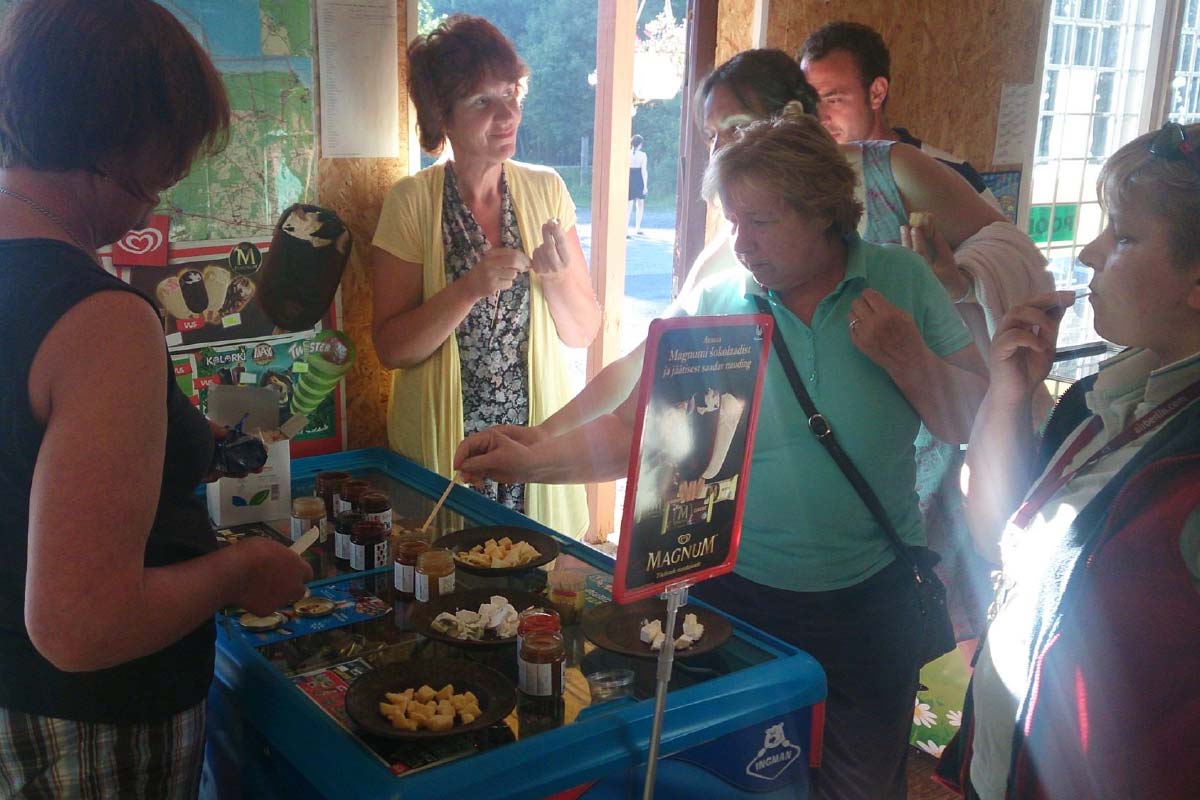
Result and summary
The shop in Leesi opened its doors on 3 July. Cheerful local young people work behind the counter and there are many local items on the shelves. The peninsula is once again a place where people can purchase basic necessities, where the paths of community members cross.
Budget
As the number of members has quietly grown, so have the financial opportunities. Therefore, budgeting is an ongoing process where plans are reviewed according to the possibilities on an ongoing basis. The building cost EUR 41,000, and together with the support received from LHV, about EUR 55,000 has been spent on the restoration works. In addition, an immeasurable number of unpaid hours have been spent by volunteers in the community. According to Ants Viirmaa, head of the association, a total of EUR 50,000 - 60,000 was saved in labour costs due to the involvement of volunteers. However, the biggest benefit of working together is not in the budget, but in how working brought the community together – both mentally and physically.
Business preparation
When it came to defining the tasks of the Leesi shop as a cooperative enterprise, the members of the cooperative found themselves at a crossroads when it came to opinions. The question was: to hand over the shop building to an operator or attempt to manage the shop themselves. It was decided that the store would be run by themselves, as it would support the functioning of the shop as a hub for the village’s cultural life. Young people from the peninsula, the next transmitters of the spirit of the village, will begin working in the shop on a daily basis. When it came to searching for suppliers and concluding contracts, the social network comprised of the cooperative’s members was useful. We managed to conclude agreements with suppliers on favourable terms, because the leaders of large companies also want to contribute to the community project.
Result
The shop in Leesi opened its doors on 3 July. Cheerful local young people work behind the counter and there are many local items on the shelves. The peninsula is once again a place where people can purchase basic necessities, where the paths of community members cross. ‘The opening of the store has drastically changed village life – it is enough to sit in front of the store for an hour, during which time you can see dozens and dozens of happy faces from the peninsula and further afield,’ says indigenous resident of Leesi and film producer Veiko.
The future
In the long run, the goal of the community is a shop that is open all year round, even if that goal is not achieved in the first year. It is also planned to bring a parcel machine and a café to the building. There is currently a design contest underway for the use of additional rooms located upstairs. The idea of building a guest apartment there has been repeatedly discussed. If the plan materialises, all other Estonians, as well as foreign tourists, can also stop by the pleasant seaside village of Leesi – Leesi is a peaceful, quiet and picturesque refuge.

Management and Construction
Ants Viirmaa, leader
For the most part, the process went quite smoothly. In terms of leadership, I can say in retrospect that we could have broken down the purpose more precisely. We quickly began to build a shop and didn't even know how it would turn out. We later realised that some saw the restoration of the building as their goal, but some looked at the picture more broadly. Fortunately, we finally came up with a reasonable solution.
With regard to the exchange of information, specific rules could have been set at the outset, so that everyone had a common understanding when it came to the flow of information. At first I published the newsletter irregularly – too frequently for some, not often enough for others. Things are much easier when everyone knows what to expect.
Some thoughts on the construction side as well: first of all, I definitely recommend that a novice builder seeks help in the form of construction supervision. By doing so, many mistakes can be avoided. Secondly, for those who are dealing with old buildings, I recommend involving the experts from the Estonian Open Air Museum. They give very practical advice – what to restore, and how, and what not to restore. Thirdly: be sure to take pictures of everything you do – right from the start. You will benefit from the pictures yourself, because you will be unable to remember all of the details in the case of a large project. Secondly, pictures are also very useful when you need to justify or prove your actions. For drawing up building permits, applying to the Environmental Board, applying for subsidies, and so on.
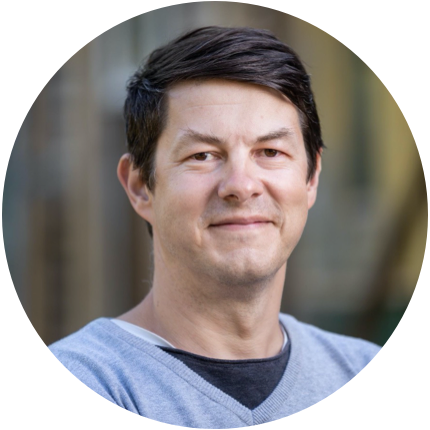
Budget
Tarmo Keller, finances
Overall, budget planning went sensibly. During price negotiations to purchase the plot, we reached a fairly reasonable agreement. We tried to gather together funds at all costs. Fortunately, enough people came to the general meeting and we were able to put together the purchase amount, with a little left over. After that, budgeting is an ongoing process. In the beginning, we didn’t know the exact condition of the building or much else, but we did what we could and what we knew how to do. Decisions had to be made on an ongoing basis. There is, however, much that can be done to deliver on a common end goal.
But what advice would I give to a beginner in a similar project? First of all, I wish you courage and perseverance! Before you begin thinking about the budget and money, I recommend using all possible social resources at your disposal. Make the most of your personal and community acquaintances! This helps you save money and also brings the community together.
When it comes to money, once you have a good idea and project you can ask for money and help everywhere. Be sure to use state resources and support measures. By the way, it is wise to use the help of specialists when making applications. This increases the likelihood that the application will succeed. In the case of an NGO, the management and communication side is very important. Everyone’s money is at stake and everyone needs to feel involved. However, not all the details can be discussed with a large group. Compromises must be found and everyone must have the same understanding of the division of roles.

Law
Randu Riiberg, law
Before talking about the legal form, it is necessary to set common goals for action. Then how it is financed, who manages the project, and how it works. Joint action requires a legal body; one that is responsible for the assets it owns – to ensure that the founders are not liable with their own assets. The statutes of that body or the shareholders’ agreement should make it possible to regulate relations between members.
Starting a community is like starting a business – it must be ensured that the people involved have similar expectations, that tasks are shared, and that everyone understands the division of roles. The legal form is of secondary importance. Once you know who is going to do what and why, putting the legal form in place is a simple detail. We established a non-profit association so that we would have the opportunity to apply for grants more easily. (The volume of self-financing for a non-profit association is usually lower). In addition, a non-profit association emphasised that we have a community project – the goal is not the size of the profit, but the existence of the store and other values.

Community
Anu Müürsepp, community leader
An important part of the project is the community and strong people, together with whom something great can be accomplished. The greatest value for me in this project is the new friends and companions with whom this project has been carried out. If there is a group of people together who all think in the same rhythm, then the energy that is generated is extremely intense. By working together, you get to know people better, you understand with whom you can go on a reconnaissance mission and with whom you cannot. I have made many new and nice friends. And when the idea has been brought to life, you will feel as sublime as if you had run a gruelling marathon and happily reached the finish line. It's hard to describe this feeling; you have to feel it for yourself and to do so you have to come up with some cool ideas and bring them to life!
